|
| DELHI TOUR PACKAGE |
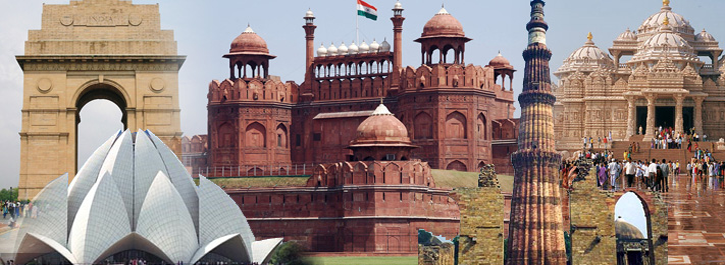 |
| |
| Akshardham Temple |
| The megha Akshardham temple complex is finally opened to the public on 8 November 2005. The temple which depicts the Hindu mythology and Indian culture promises to attract lakhs of tourists’ every year with its religious tourism. Build over an area of 100 acres on the banks of the Yamuna River, it took more than 2 years for construction and costed around Rs.2 billion, funded by millions of Bochasanvasi Aksharpurushottam Swaminarayan Sanstha (BAPS) followers worldwide. The temple has 234 ornate pillars, 20,000 statues and many arches. Besides the Swaminarayan temple the complex consists of the main monument, exhibition halls, an IMAX theatre and a musical fountain, surrounded by a garden. |
|
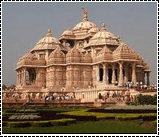 |
|
| |
| India Gate, Delhi |
| This solemn monument was built in memory of the 90,000 Indian soldiers who died in World War I. It was built in 1931, designed by Lutyens, and was originally called the All India War Memorial. The names of the soldiers are inscribed on the walls of the arc of the gate. Later in 1971, an eternal flame was lit here in memory of the unknown soldiers who died in the 1971 Indo-Pakistan war. India Gate stands at the end of Rajpath, and is a popular picnic site especially during hot summer evenings. At night, the Gate is brightly lit and the fountains near the Gate are lit with coloured lights. The sight is delightful. |
|
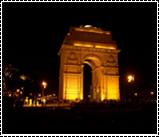 |
|
| |
| Jama Masjid |
| Jama Masjid was built by Shah Jahan in 1658, it is one of the largest mosques in India with a seating capacity of more than 20,000.The mosque is situated near the Red Fort in old Delhi. This is the area that still retains the traditional charm of markets in Mughal times. The bulbous domes and tapering minarets built with marble stand strong and beautiful even to this day. This mosque has three gateways, four angle towers and two 40 m. high minarets. You can even go to the top of minarets and have a bird's eye view of Delhi. |
|
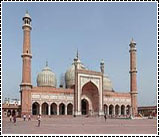 |
|
| |
| Lotus Temple |
| In the heart of New Delhi, the bustling capital of India, a lotus-shaped outline has etched itself on the consciousness of the city's inhabitants, capturing their imagination, fuelling their curiosity, and revolutionising the concept of worship. This is the Bahá'í Mashriqu'l-Adhkar, better known as the "Lotus Temple". With the dawning of every new day, an ever-rising tide of visitors surges to its doorsteps to savour its beauty and bask in its serenely spiritual atmosphere. Since its dedication to public worship in December 1986, this Mother Temple of the Indian sub-continent has seen millions of people cross its threshold, making it one of the most visited edifices in India. |
|
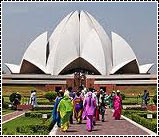 |
|
| |
| Chandni Chowk |
| It was the eyes and ears of the Mughal's commercial instincts and is today one of the country's best known wholesale markets for textiles, electronic goods and watches. The entire area was designed by Jahanara Begum, Shah Jahan's favourite daughter and was then inhabited by the well-to-do families of that time. There is however a word of caution and that is that there are several elements who are believed to be selling duplicate goods and the tourist needs to be careful about this. |
|
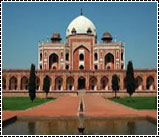 |
|
| |
| The Red Fort |
| The Red Fort, with a circumference of over 2.2 kilometers, was laid out by the banks of the Yamuna river in the 17th century. The Mughal emperor Shahjahan built it with the ambition of concentrating the Mughal power in one monument. Monument is perhaps not the right word. A mini-city is more like it. Unfortunately for the emperor, before he could move his capital from Agra to Shahjahanabad in Delhi, he was taken a political prisoner by his son Aurangazeb. The fort is a delight to one's imagination. Imagine the Naqqar Khana (Drum room) also called Naubat Khana (Welcome Room), where once drums loudly heralded the arrival of the emperor and the Diwan-e-Am (Hall of Public Audience) resounded with the incantations of the people. |
|
 |
|
| |
| Qutub Minar In Delhi |
| Qutb Minar is one of the famous monuments of the world and the tallest brick structure of the world. History reveals that this monument was built ruining the ancient Hindu temples centuriesback. There are other ancient monuments that stand surrounding Qutb Minar and are collectively known as Qutb complex. The monument is also spelled as Qutub Minar. |
|
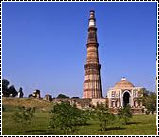 |
|
| |
| Humayun's Tomb |
| The second Mughal Emperor Humayun died just a year after he regained Delhi. His Persian wife, Hamida Begum, supervised the construction of his tomb from 1562-1572. It was designed by the Persian architect, Mirak Mirza Ghiyuath. Situated on the bank of River Yamuna and adjoining the shrine of the famous Sufi saint Nizam al-Din Auliya, this tomb is said to have been a precedent of later Mughal mausoleums in India. The geometrically arranged gardens intersected with numerous water channels present a paradise setting. |
|
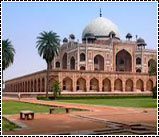 |
|
|
|